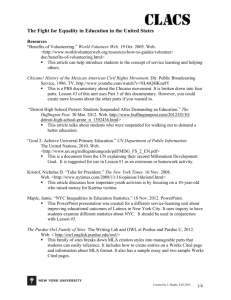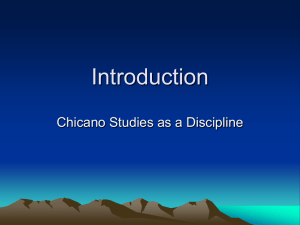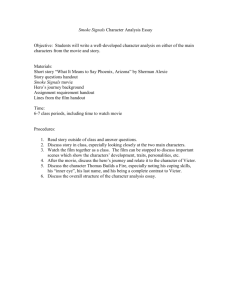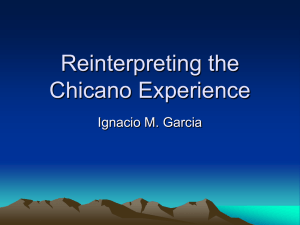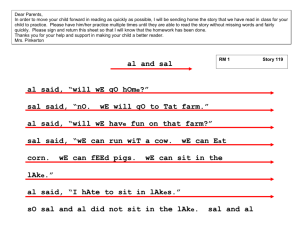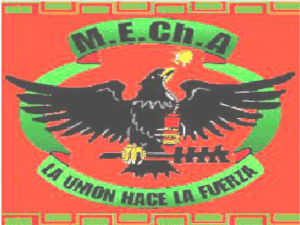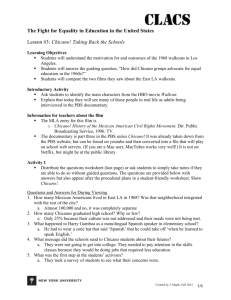The Fight for Equality in Education in the United States Lesson #2
advertisement
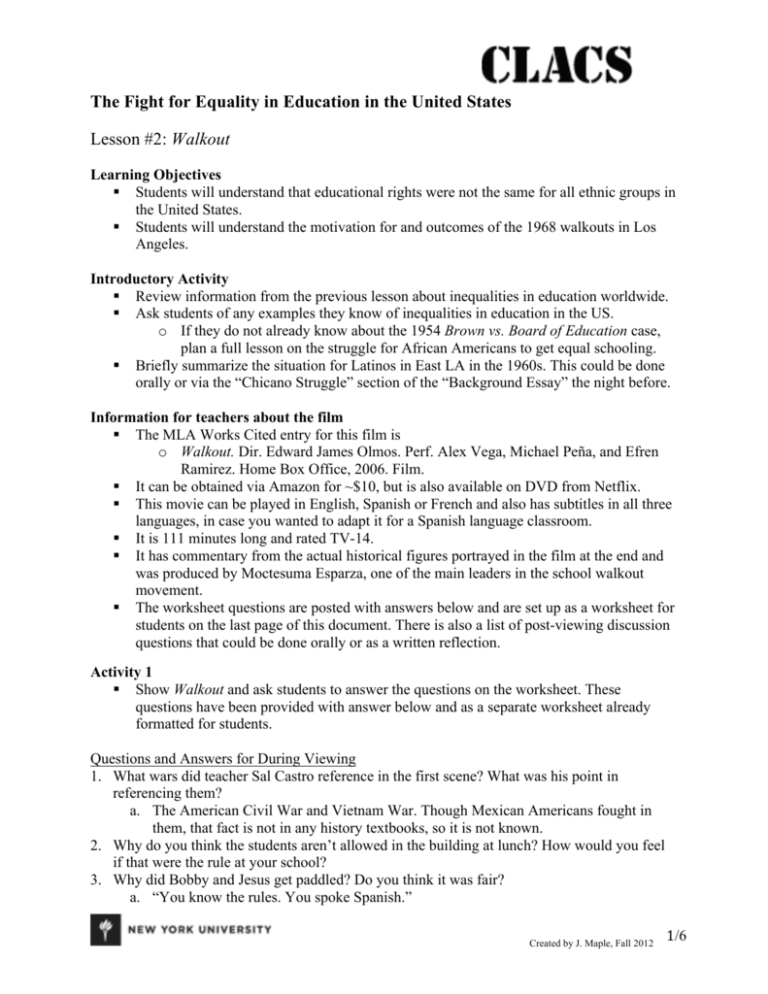
The Fight for Equality in Education in the United States Lesson #2: Walkout Learning Objectives § Students will understand that educational rights were not the same for all ethnic groups in the United States. § Students will understand the motivation for and outcomes of the 1968 walkouts in Los Angeles. Introductory Activity § Review information from the previous lesson about inequalities in education worldwide. § Ask students of any examples they know of inequalities in education in the US. o If they do not already know about the 1954 Brown vs. Board of Education case, plan a full lesson on the struggle for African Americans to get equal schooling. § Briefly summarize the situation for Latinos in East LA in the 1960s. This could be done orally or via the “Chicano Struggle” section of the “Background Essay” the night before. Information for teachers about the film § The MLA Works Cited entry for this film is o Walkout. Dir. Edward James Olmos. Perf. Alex Vega, Michael Peña, and Efren Ramirez. Home Box Office, 2006. Film. § It can be obtained via Amazon for ~$10, but is also available on DVD from Netflix. § This movie can be played in English, Spanish or French and also has subtitles in all three languages, in case you wanted to adapt it for a Spanish language classroom. § It is 111 minutes long and rated TV-14. § It has commentary from the actual historical figures portrayed in the film at the end and was produced by Moctesuma Esparza, one of the main leaders in the school walkout movement. § The worksheet questions are posted with answers below and are set up as a worksheet for students on the last page of this document. There is also a list of post-viewing discussion questions that could be done orally or as a written reflection. Activity 1 § Show Walkout and ask students to answer the questions on the worksheet. These questions have been provided with answer below and as a separate worksheet already formatted for students. Questions and Answers for During Viewing 1. What wars did teacher Sal Castro reference in the first scene? What was his point in referencing them? a. The American Civil War and Vietnam War. Though Mexican Americans fought in them, that fact is not in any history textbooks, so it is not known. 2. Why do you think the students aren’t allowed in the building at lunch? How would you feel if that were the rule at your school? 3. Why did Bobby and Jesus get paddled? Do you think it was fair? a. “You know the rules. You spoke Spanish.” Created by J. Maple, Fall 2012 1/6 4. How many Mexican Americans graduate high school according to Sal? Do you think that statistic is still true today? a. 1/4 or 25% 5. According to the movie, what percentage of Chicanos make it into college? a. 2% 6. What is the relationship between college and history, according to Sal? a. “Without education, someone else is writing our history.” 7. What are the differences between the Chicano high school and the high school Paula and Sal stop at on the way home from the leadership conference? a. The other high school, Palos Verdes, is much nicer, with a senior courtyard, unlocked bathrooms and a huge library that has books in multiple languages including Spanish. 8. What do some of the brown berets advocate for? a. Using violence to achieve their goals. 9. What movements do the students reference when they decide to boycott schools? a. Martin Luther King’s boycott of buses in Montgomery. b. Cesar Chavez’ boycott of grapes with the United Farm Workers. 10. What does Paula’s father mean by ‘agitators’? a. People who stir up political trouble. 11. What are some of the 39 things that the Chicano students ask the principals for? a. Mexican food in cafeterias b. Covered lunch areas c. No janitorial punishment d. Teachers that show prejudice should be transferred e. New schools f. Compulsory bilingual education 12. What languages was the original California constitution written in? a. English and Spanish. They were both official languages at the time. 13. Why didn’t the walkout at Wilson count? a. It wasn’t in any of the papers, so it didn’t happen, since no one knew about it. 14. Why did the organizers tell the brown berets to go first? a. They wanted the high school students to be protected. 15. What did Paula’s sign say? a. Equal education for all. 16. What law did the cops site when the kids walked out again? a. Unlawful assembly 17. What did Garfield do when the kids wouldn’t walk out? a. Pulled the fire alarm 18. What did the police do during the second walkout? a. Entered the schools, beat the students, locked the gates to keep the kids inside 19. Why was communism mentioned in the film? a. It was a hot cultural topic at the time because of the Vietnam War. The media said the kids were cooperating with radical groups with ties to communism. 20. Who was arrested? What were they charged with? What was the maximum punishment? a. Moctesuma, David, Carlos and Sal, among others were arrested. They were charged with conspiracy to commit a misdemeanor, which is a felony punishable by up to 66 years in prison. 21. Why didn’t Robert get arrested? Created by J. Maple, Fall 2012 2/6 a. He was an undercover cop. 22. What did the Chicano community do to free the East LA 13? a. They staged a protest at the police station/court house. Eventually, the charges were thrown out on court appeal. 23. What did the students accomplish with the walkout? a. They changed themselves and learned to stand up for their rights. Chicano enrollment in college went from 2% to 25% across the country. By the fall of 1969, Chicano enrollment at UCLA went from 40 students to 1200. Activity 2- Discuss the movie with students, either as a whole class, in groups, or in writing if class time is limited. Question number 9 is reproduced on the student handout. Post-viewing Discussion Questions 1. Do you think there is anything unrealistic about the movie? If so, why would the director choose to include it? 2. Do you think it took courage for Paula to do what she did? Why or why not? 3. What role did the news media play? Why do you think the footage of the kids getting beaten didn’t get published? Does the news media still play that role today? 4. What factor did money play in the walkouts? 5. What role did parents and community members play? 6. Does the fact that the actual people who were portrayed in the movie appeared at the end lend the film credibility? Why or why not? 7. Do you know of current American schools were the bathrooms are locked? 8. What could have happened during a stampede like that? 9. Respond to the following quotes. a. “You’re either Mexican or American. You can’t be both.” b. “This is East LA. Not everybody can write.” c. “Radical reform doesn’t happen overnight.” d. “If you want to live in this country, you must be willing to die for it. All the good things we have in America, it’s not for free.” e. “Everyone has beliefs. If you want to inspire people with your beliefs, you have to get organized.” f. “Yeah, it was worth it. The schools may not have changed, but we did.” g. “It focused the attention of the Chicanos in the city.” h. “The blowouts made us realize that collectively we had a strong voice. It gave us a power we didn’t realize we had before” i. “It was beautiful to be a Chicano that day.” Closing § Return to the question about how realistic a movie they think Walkout is. Discuss who the intended audience is and what the purpose of the film was (primarily to entertain). Discuss who made the movie (HBO) and how that tells us what the movie’s purpose was. Explain that the next class period they will be watching another film whose primary purpose is to inform. Created by J. Maple, Fall 2012 3/6 Class_______________ Date _______________ Name ______________ Walkout Instructions: As you watch the movie, answer the following questions. 1. What wars did teacher Sal Castro reference in the first scene? What was his point in referencing them? 2. Why do you think the students aren’t allowed in the building at lunch? How would you feel if that were the rule at your school? 3. Why did Bobby and Jesus get paddled? Do you think it was fair? 4. How many Mexican Americans graduate high school according to Sal? Do you think that statistic is still true today? Why or why not? 5. According to the movie, what percentage of Chicanos make it into college? 6. What is the relationship between college and history, according to Sal? 7. What are the differences between the Chicano high school and the high school Paula and Sal stop at on the way home from the leadership conference? 8. What do some of the brown berets advocate for? Created by J. Maple, Fall 2012 4/6 9. What movements do the students reference when they decide to boycott schools? 10. What does Paula’s father mean by ‘agitators’? 11. What are some of the 39 things that the Chicano students ask the principals for? 12. What languages was the original California constitution written in? 13. Why didn’t the first walkout at Wilson count? 14. Why did the organizers tell the brown berets to go first? 15. What did Paula’s sign say? 16. What law did the cops site when the kids walked out again? 17. What did Garfield do when the kids wouldn’t walk out? 18. What did the police do during the second walkout? 19. Why was communism mentioned in the film? 20. Who was arrested? What were they charged with? What was the maximum punishment? 21. Why didn’t Robert get arrested? 22. What did the Chicano community do to free the East LA 13? Created by J. Maple, Fall 2012 5/6 23. What did the students accomplish with the walkout? 24. Respond to the following quotes: a. “You’re either Mexican or American. You can’t be both.” b. “This is East LA. Not everybody can write.” c. “Radical reform doesn’t happen overnight.” d. “If you want to live in this country, you must be willing to die for it. All the good things we have in America, it’s not for free.” e. “Everyone has beliefs. If you want to inspire people with your beliefs, you have to get organized.” f. “Yeah, it was worth it. The schools may not have changed, but we did.” g. “The blowouts made us realize that collectively we had a strong voice. It gave us a power we didn’t realize we had before.” h. “It was beautiful to be a Chicano that day.” Created by J. Maple, Fall 2012 6/6


